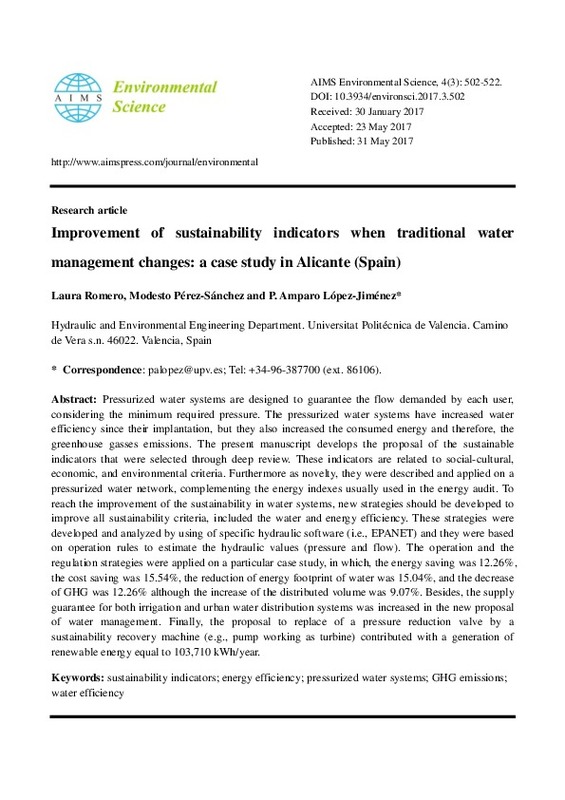JavaScript is disabled for your browser. Some features of this site may not work without it.
Buscar en RiuNet
Listar
Mi cuenta
Estadísticas
Ayuda RiuNet
Admin. UPV
Improvement of sustainability indicators when traditional water management changes: a case study in Alicante (Spain)
Mostrar el registro sencillo del ítem
Ficheros en el ítem
| dc.contributor.author | Romero, Laura
|
es_ES |
| dc.contributor.author | Pérez-Sánchez, Modesto
|
es_ES |
| dc.contributor.author | López Jiménez, Petra Amparo
|
es_ES |
| dc.date.accessioned | 2017-07-05T10:33:01Z | |
| dc.date.available | 2017-07-05T10:33:01Z | |
| dc.date.issued | 2017-05-31 | |
| dc.identifier.issn | 2372-0352 | |
| dc.identifier.uri | http://hdl.handle.net/10251/84491 | |
| dc.description.abstract | Pressurized water systems are designed to guarantee the flow demanded by each user, considering the minimum required pressure. The pressurized water systems have increased water efficiency since their implantation, but they also increased the consumed energy and therefore, the greenhouse gasses emissions. The present manuscript develops the proposal of the sustainable indicators that were selected through deep review. These indicators are related to social-cultural, economic, and environmental criteria. Furthermore as novelty, they were described and applied on a pressurized water network, complementing the energy indexes usually used in the energy audit. To reach the improvement of the sustainability in water systems, new strategies should be developed to improve all sustainability criteria, included the water and energy efficiency. These strategies were developed and analyzed by using of specific hydraulic software (i.e., EPANET) and they were based on operation rules to estimate the hydraulic values (pressure and flow). The operation and the regulation strategies were applied on a particular case study, in which, the energy saving was 12.26%, the cost saving was 15.54%, the reduction of energy footprint of water was 15.04%, and the decrease of GHG was 12.26% although the increase of the distributed volume was 9.07%. Besides, the supply guarantee for both irrigation and urban water distribution systems was increased in the new proposal of water management. Finally, the proposal to replace of a pressure reduction valve by a sustainability recovery machine (e.g., pump working as turbine) contributed with a generation of renewable energy equal to 103,710 kWh/year. | es_ES |
| dc.language | Inglés | es_ES |
| dc.publisher | AIMS Press | es_ES |
| dc.relation.ispartof | AIMS Environmental Science | es_ES |
| dc.rights | Reconocimiento - No comercial (by-nc) | es_ES |
| dc.subject | Sustainability indicators | es_ES |
| dc.subject | Energy efficiency | es_ES |
| dc.subject | Pressurized water systems | es_ES |
| dc.subject | GHG emissions | es_ES |
| dc.subject | Water efficiency | es_ES |
| dc.subject.classification | INGENIERIA HIDRAULICA | es_ES |
| dc.subject.classification | MECANICA DE FLUIDOS | es_ES |
| dc.title | Improvement of sustainability indicators when traditional water management changes: a case study in Alicante (Spain) | es_ES |
| dc.type | Artículo | es_ES |
| dc.identifier.doi | 10.3934/environsci.2017.3.502 | |
| dc.rights.accessRights | Abierto | es_ES |
| dc.contributor.affiliation | Universitat Politècnica de València. Departamento de Ingeniería Hidráulica y Medio Ambiente - Departament d'Enginyeria Hidràulica i Medi Ambient | es_ES |
| dc.description.bibliographicCitation | Romero, L.; Pérez-Sánchez, M.; López Jiménez, PA. (2017). Improvement of sustainability indicators when traditional water management changes: a case study in Alicante (Spain). AIMS Environmental Science. 4(3):502-522. doi:10.3934/environsci.2017.3.502 | es_ES |
| dc.description.accrualMethod | S | es_ES |
| dc.relation.publisherversion | http://dx.doi.org/10.3934/environsci.2017.3.502 | es_ES |
| dc.description.upvformatpinicio | 502 | es_ES |
| dc.description.upvformatpfin | 522 | es_ES |
| dc.type.version | info:eu-repo/semantics/publishedVersion | es_ES |
| dc.description.volume | 4 | es_ES |
| dc.description.issue | 3 | es_ES |
| dc.relation.senia | 338194 | es_ES |
| dc.identifier.eissn | 2372-0352 |








